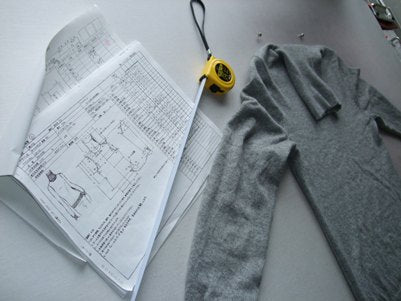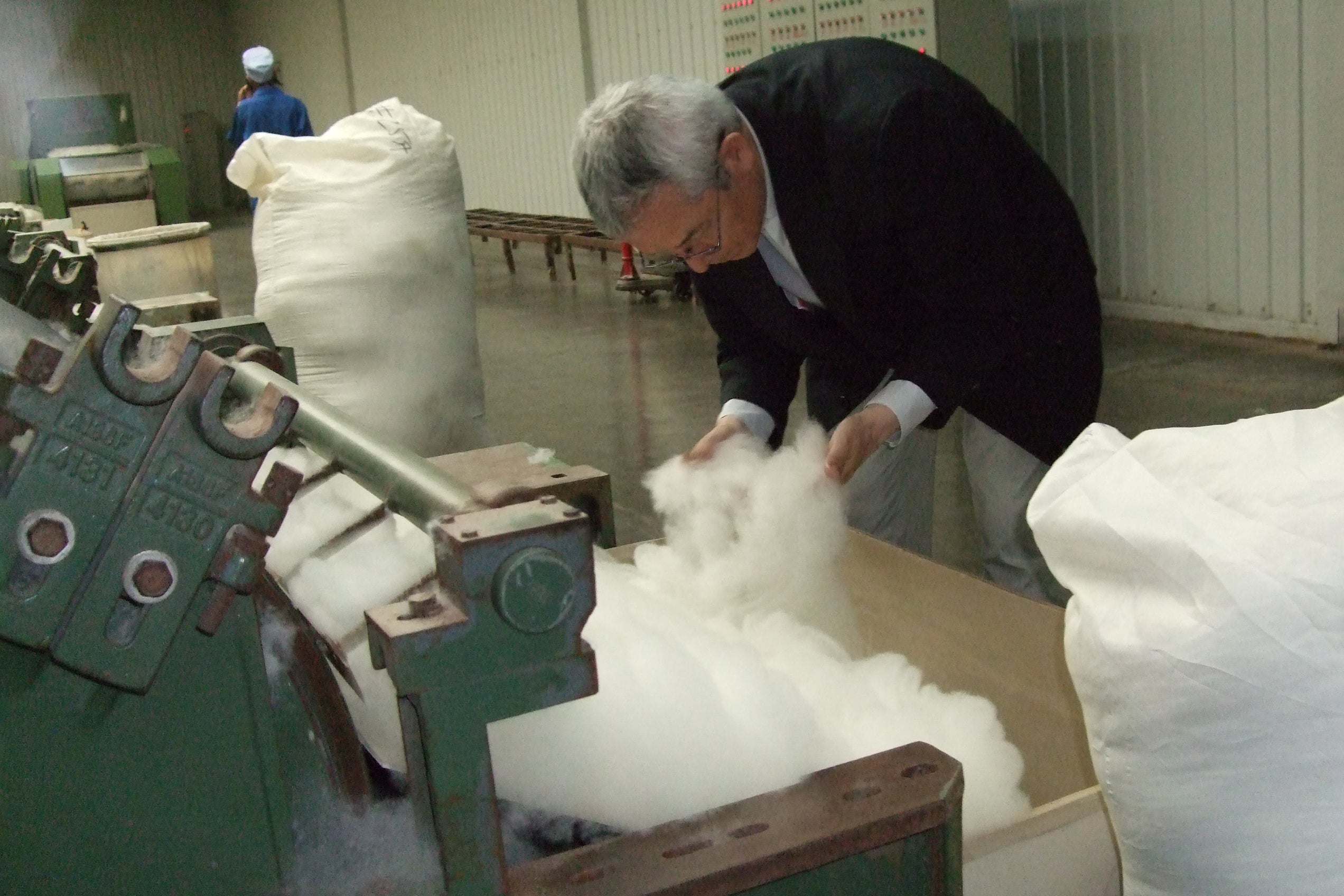探访羊绒之家:人类是否在滥用羊绒?我想找出答案。

参观羊绒之家
人类是否在滥用羊绒?我想弄清楚。
想寻找世界上最好的羊绒,就去中国阿拉善——这片尚未开发的地区。
羊绒产自生活在中国内蒙古和蒙古国高原、中亚戈壁沙漠、吉尔吉斯斯坦塔克拉玛干沙漠周边地区、印度和阿富汗等气候严酷地区的羊绒山羊的绒毛。其中,中国内蒙古出产的羊绒品质最高。
我此行有一个秘密目的。我此行到内蒙古只有一个秘密目的:“在羊绒山羊的养殖和采摘过程中是否存在虐待羊绒的行为?” 我的目的是调查羊绒的养殖和采摘过程中是否存在虐待羊绒的行为。
这是因为我认为,要想成为以羊绒为主营业务的世界第一羊绒制造商,“羊绒与人类必须建立双赢关系”。虽然我认为这不可能,但如果人类为了获取羊绒绒毛而滥用羊绒,那将是一件非常可惜的事情,所以我准备放弃羊绒生意。
这是因为我了解到了藏羚羊(一种生活在西藏的动物)与人类之间一段令人悲伤的历史。是Keken(Keken认证中心)的木村先生告诉我的。
*Keken 原名毛发检验协会,是国际贸易工业部的一个附属机构,专门对羊绒和其他产品进行评判。
藏羚羊是牛科动物,生活在西藏高原及亚洲其他地区,其毛发比羊绒更细。藏羚羊无法被驯化,生活在西藏海拔3000米以上的高海拔地区。用藏羚羊毛制成的围巾被认为是世界上最好的羊毛,但为了获得这种羊毛,必须猎杀藏羚羊并采集其毛发。藏羚羊是濒危物种,其毛发采集已被《华盛顿公约》禁止。
我怀着第一次见到真正羊绒的期待踏上旅程,同时也略带一丝担忧,害怕会遇到羊绒被滥用的情况。

探索羊绒与人类之间的良好关系
时值五月底,中国内蒙古阿拉森市春意盎然。
前往阿拉森,可先从日本飞往北京,然后转乘国内航班,再向西内陆飞行约两小时。银川是最近的城市。
银川是宁夏回族自治区的首府。成吉思汗时期,这里曾是西夏王国的所在地。银川毗邻黄土高原,黄土高原是远销日本的黄沙的源头,而银川本身则是黄河中游一座水资源丰富、物产丰饶的城市。
离开银川的那天早上,黄沙已经停了,昨天还漫天飞舞,连街对面的房子都看不见,天气也晴朗了。为了以防万一,我们在车里装了不少瓶装水,然后出发了!
银川市外是一片荒凉的半沙漠,我们沿着一条时断时续穿过沙漠的柏油路,驱车前往与内蒙古接壤的呼罗珊山脉。
这些山脉是半沙漠地带,完全没有树木,只有一些草和灌木,两侧是广阔的土地,群山一直延伸到地平线之外。
当我们到达分隔宁夏回族自治区和内蒙古自治区的加兰山脉中点时,残破的长城映入眼帘,我们这才意识到我们已经走了多远。
翻越海拔1600米的山隘,进入内蒙古后,我们看到了阿拉善的左侧旗帜。我内心无比激动,意识到我们终于到达了阿拉善。
在这里,我们遇到了羊绒收藏家刘先生,他带我们去了牧民杜女士的家和牧场。
刘先生的车开了一会儿后,突然驶离了柏油路,进入了半沙漠地带。当车子进入沙地时,沙地上还能隐约看到车辙,车身剧烈摇晃,车头都碰到了车顶。
如果没有刘先生的指引,在广袤的沙漠中找到牧民的家是不可能的。
杜先生和他的妻子热情地接待了我们,他们父辈一直从事羊绒牧民的工作。房子孤零零地坐落在一片广袤的半沙漠之中。房屋外观是简朴的砖砌结构,但内部却比我想象中明亮得多。
杜先生家共有四口人。两个女儿分别就读小学和初中,因为家住偏远,上学不方便,所以她们住在寄宿家庭,盼望着周末回家。我们到家时,他们给我们端来了羊奶茶和“羊油炸豆饼”,味道很不错。
羊绒一年只收割一次。由于这是杜先生和杜太太一年中最忙的时候,我们把从日本带回来的纪念品送给他们,并请他们向我们展示羊绒是如何收割的。
杜先生说了声“好”,便一把抓住那只毛茸茸的羊绒猫的腿,迅速地把她的前腿和后腿分别绑在了两边。卡什米娅吓了一跳,扑腾着腿。我也很惊讶,心想他为什么要把她绑起来。但很快,周围就安静了下来。
与用剪刀剪羊毛不同,剪羊绒是用类似耙子的工具,梳理长鬃毛内的绒毛。我知道像奇鲁那样弄死羊绒羊并非最糟糕的事,但我现在担心梳理羊绒羊会伤到它。然而,出乎我意料的是,羊绒羊非常温顺。

我亲眼目睹了羊绒与人类之间良好的关系,这让我既感到欣慰又印象深刻。
与用剪刀剪羊毛不同,羊绒剪毛是用耙子之类的工具梳理长鬃毛内的绒毛。
每次梳理都能梳出大量的绒毛。这些绒毛又长又细又软,连我都能看出它们是极好的绒毛。
我坦诚地向杜先生询问了我的疑问和担忧。
杜先生面带微笑地回答了我那些无礼的问题。
他笑着问我:“羊绒真的可以一辈子都遭受虐待吗?”
“卡什米娅是我们珍贵的家庭成员和财产,她从小就和我们生活在一起。周末女儿们从寄宿学校回家时,她是她们最好的玩伴,所以她不可能受到虐待。”
“对人类来说,头发被拔掉是很痛苦的,但对羊绒来说,绒毛被拔掉却不觉得痛苦?”
“羊绒的绒毛是冬季毛发,夏天自然会重新长出来,我们明白这一点。”
“梳理羊绒不会感到疼痛,因为它本身就会自然脱落。如果不梳理,羊绒要么会自然脱落,要么会摩擦岩石或其他物体来去除毛发。这些毛发容易沾染沙子,造成损伤,所以在这个季节梳理羊绒对羊绒有益。”
剪羊毛时不会把羊羔绑起来,为什么要绑住羊绒羊的腿呢?
羊不像绵羊那样温顺,所以我们轻轻地拴住它们,以免它们失控伤人。这样它们很快就会变得温顺。
他用一种让我疑惑的眼神看着我,让我不禁想知道他为什么要问我这样的问题。
它们在被梳毛的时候其实很温顺,而且它们黄褐色的眼睛看起来也很讨人喜欢。
我在日本的经历告诉我,我绝不会虐待它们,但我不知道它们是冬季自然脱落的绒毛,所以当我担心梳理羊绒是否会疼痛的疑虑消除后,我感到非常欣慰,并且无比高兴能够继续从事羊绒相关的工作。
梳理过的羊绒衫让人感觉神清气爽,就像刚从理发店出来一样。临近中午,即使到了五月,室外温度也超过了30摄氏度。空气干燥,所以没有出汗,但阳光非常刺眼。接下来几天气温还会继续超过40摄氏度,如果不得不穿上冬装,那就太可惜了。
梳毛五分钟后,我的胳膊就酸了,很快就放弃了。杜先生和杜太太的手梳理羊毛又快又有节奏,大约花了一个小时才完成。电视上剪羊毛只需要五分钟,但与剪羊毛相比,收集羊绒绒的毛发要辛苦得多。
来这里之前,我一直隐隐担心,为了保护人类,羊绒可能会被强行剪掉。得知这是一件好事,我真的很高兴。知道这一点,是我这次旅行中最美好的部分。
从杜先生家返回的路上,我们驱车穿过内蒙古广袤的半沙漠,这片沙漠仿佛延伸至天际,路边不时可见成群的白色绒山羊在田野里悠闲地吃草。这是一次非常愉快的羊绒故乡之行。







